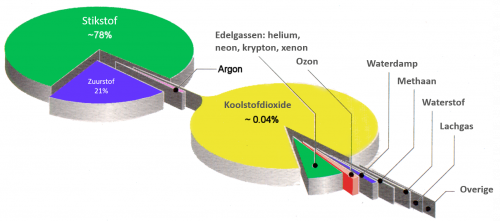The substances that determine the composition of the atmosphere in our immediate vicinity (= air quality) and/or the average "weather" over a long-term period (= climate) together occupy only 1% of the volume of the atmosphere (in dry air).
Earth's atmosphere consists of 99% nitrogen and oxygen
When we examine the quantities of gases present, we see that most of the Earth's atmosphere consists of nitrogen (N2)(78%) and oxygen (O2)(21%), together accounting for 99% of the atmosphere.
Oxygen, among other things, allows us to breathe and is an essential element that makes life on Earth possible. Compare the percentages in the atmosphere of our planet Earth with those of our neighboring planets in the solar system, where humans would not be able to breathe and would consequently suffocate:
- the atmosphere of Venus with 96.5% carbon dioxide (CO2) and 3.5% nitrogen (N2)
- the atmosphere of Mars with 95.3% carbon dioxide (CO2) and 2.7% nitrogen (N2)
Very small quantities of atmospheric gases (1%) with a great impact
In addition to nitrogen and oxygen, if we take a closer look at the remaining volume of the Earth's atmosphere, we find all the other gases in it.
For example:
- Noble gases (helium, neon, krypton, xenon)
- Carbon dioxide CO2
- Ozone O3
- Water H2O
- Methane CH4
- Nitrogen oxides NOx
- Nitrous oxide N2O
This list is incomplete, as the atmosphere is made up of hundreds of these gases, each of which makes up less than 1% of the atmosphere. They are trace gases or minority constituents.
Their concentrations in the atmosphere-say the quantities-are so small that we speak of the number of molecules per million particles (e.g., CO2, CH4, CO) or per billion (e.g., NOx, SO2) or more (e.g., HONO). Yet satellites are able to detect them. And fortunately so, because air quality and climate are entirely determined by these substances.
Their chemical properties and their capacity to absorb radiation from the sun and the earth's surface to a greater or lesser extent mean that in relatively small quantities these trace gases still have a gigantic impact on air quality and the climate.
Regulations on air pollution and climate change mean regulations on trace gases
When the international community imposes limits on the concentrations of air pollutants that are harmful to health and the environment, or in the context of climate change takes measures to reduce man-made greenhouse gases (climate mitigation), it is therefore dealing with agreements related to trace gases in the atmosphere.




